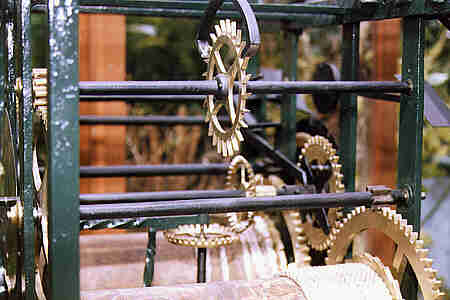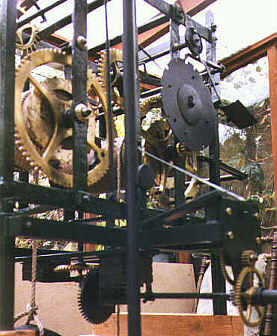The Princes Risborough Clock
How it works...a simplified version.
By someone who doesn't know anything about clocks.

The winding drum on the left provides the power for the chiming
The weight which is attached to the rope wound around the winding drum, at the bottom of the picture, is trying to turn it. The large cog on the right hand end of the winding drum meshes with a smaller one on the shaft just above it. At the left hand end of this shaft can just be seen another large cog meshing with a smaller one above that. In the centre of this shaft, the cog with the long teeth is being engaged by the semi-circular Escape Anchor. This is what is stopping the mechanism from unwinding. The Escape Anchor is on a shaft that is connected to the pendulum. As the pendulum swings, the Escape Anchor is turned allowing one tooth to be released before the pendulum swings back. So the rope slowly unwinds. As it does so the large cog on the end of the winding drum turns a cog that is connected to a shaft leading to the hands.
The large cog on the end of the Time winding drum turns one which is connected to the shaft going to the hands. This cog completes a revolution once an hour, and has a pin on the back. Every hour, this pin pushes down on the end of a pivoted rod. The other end of this rod has a hook that catches into one of 12 slots cut around the edge of a round (black) plate. This is on the end of a shaft with a cog meshing with one on the end of the Chime winding drum below. The slots around the edge of this plate are cut at an ever increasing distance apart. The cog on the end of the Chime winding drum has twelve pins protruding around its side. As this cog moves, each pin in turn depresses a bar that activates the bell chiming mechanism. On the hour, when the pin at the back of the Time cog holds down the end of the rod, the hook at the other end is disengaged from the slot on the plate, allowing the plate (and winding drum) to turn until the hook catches in the next slot. As it turns, the pins sticking out of the end of the winding drum are hitting the bar that chimes the bell. The number of chimes is determined by the distance between the slots in the circular plate - the greater the distance between the slots the farther the drum can turn and the more pins on the cog hit the bar, each one causing the bell to chime. On the Risborough Clock, running concurrently with this, the mechanism for striking the bell is being primed. Also driven off the Chime pin cog, via the gearing of an intermediate shaft, is the governor - two paddles on each end of a bar. This is spun at high speed as the winding drum turns, and the air resistance of the paddles slows the speed of the mechanism and increases the time between chimes. For completeness, on the intermediate shaft is a slotted wheel that catches a bar which acts as a brake.
|

